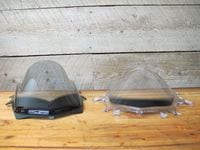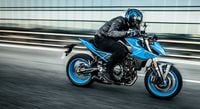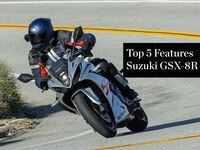WRIST: Zack Courts
MSRP (2015): $16,490
MILES: 2,109
MPG: 33
MODS: Puig windscreen
It's no secret that the Yamaha R1 isn't the best touring bike, but dammit that won't keep me from trying! In truth, a major improvement in wind protection isn't a realistic goal for this bike, but being tall (6-foot-2) I figured I would give a taller windscreen a try. Despite the aggressive name, the Racing Screen from Puig (puigusa.com; $96) adds 30mm of height (around 1.2 inches), which seemed like a reasonable place to start for street use.
As it happens, the real trick is getting the stock unit off the bike. Four obvious screws hold the screen in place, but that’s just the beginning. There is a slightly complex system of tabs holding the OE screen in place, which means the whole “windshield assembly” (that includes the screen and upper nose panel) needs to be unbolted and folded forward—picture a reverse hood on an old British sports car. That allows easy access to remove and replace the screen. At the end of the process, it’s worth noting that the Puig screen does not nestle into the same sub-frame brackets that the OE unit does, meaning it’s not braced quite as thoroughly.
Once installed there’s no doubt the Puig screen is taller (see photo), but I don’t think it looks out of place. In practice, the results aren’t groundbreaking. I’m happy to say that even though the aftermarket piece isn’t braced as well, it’s still perfectly stable at freeway speeds. Puig claims a 28 percent improvement in aerodynamic wind protection, and also admits that’s for someone 5-foot-9. There’s definitely a larger pocket of still air over the fuel tank, but for me that’s not the biggest benefit. The R1’s bodywork is so snug that my long torso means my eye line to the dash is nearly blocked by the stock screen. The taller screen also opens up the cockpit and allows me to see the display without hunching my shoulders.
Also of note, it’s clearly easier to tuck in behind the taller piece—and the light smoke option I chose is still easy enough to see through. Originally I nabbed this screen in the interest of a little more comfort on the street, but truthfully it doesn’t make a significant difference to for me. However, I’m excited to try it out at a track day. I think it could be noticeably calmer behind the Puig screen (even lacking the stability tabs that attach to the front subframe) once I sink my teeth into triple-digit speeds. Alas, officially we’ll have to wait on that.


/cloudfront-us-east-1.images.arcpublishing.com/octane/D2BDYKKNZ5GRHGDMI4PZTGRMME.jpg)

/cloudfront-us-east-1.images.arcpublishing.com/octane/UAY4WSZPOFDQRP4MCEXAKDFQOQ.jpg)

/cloudfront-us-east-1.images.arcpublishing.com/octane/X5CE3KSJHZHM5CUFGPZ7U26WB4.jpg)
/cloudfront-us-east-1.images.arcpublishing.com/octane/COWLTPGFAFGDDGJCTENYMA4VJM.jpg)
/cloudfront-us-east-1.images.arcpublishing.com/octane/H3PKUGPSUJFTND4RFPSI4OIDCE.jpg)
/cloudfront-us-east-1.images.arcpublishing.com/octane/UHGQA3MQDFCA3HLBWF7S76WH6Y.jpg)
/cloudfront-us-east-1.images.arcpublishing.com/octane/Q5EORCSTNFAVBJC4IYUHIKJTXQ.jpg)
/cloudfront-us-east-1.images.arcpublishing.com/octane/XIJ5FUFSP5A3NL7MOVZGJXAHC4.jpg)
/cloudfront-us-east-1.images.arcpublishing.com/octane/V5NZN3CGS5B5PPYFYJHIPAU5S4.jpg)
/cloudfront-us-east-1.images.arcpublishing.com/octane/CZE6ONOBU5E7HPIEEADU376C4M.jpg)
/cloudfront-us-east-1.images.arcpublishing.com/octane/UT4KL3SIYJBSPNHWJXTBE6MTGE.jpg)
/cloudfront-us-east-1.images.arcpublishing.com/octane/Q3UOIDZ22ZEVDBZUWGJXIMGJKI.jpg)
/cloudfront-us-east-1.images.arcpublishing.com/octane/YQM66WXZV5AAXNNOIUVOGVXZMY.jpg)
/cloudfront-us-east-1.images.arcpublishing.com/octane/J47NFTXNLFFGHELHZCUD2LCITA.jpg)
/cloudfront-us-east-1.images.arcpublishing.com/octane/NXPQBTLX3NCILKQ2GCFJYNIDEM.jpg)
/cloudfront-us-east-1.images.arcpublishing.com/octane/6U7NJLAYMRBZTIGNKWIA5OK2FQ.jpg)
/cloudfront-us-east-1.images.arcpublishing.com/octane/IYTZQWUROVC25IMTDEWUDQ5IQE.jpg)
/cloudfront-us-east-1.images.arcpublishing.com/octane/YJODDXEL2ZB5TENKPPN4BEYJAE.jpg)
/cloudfront-us-east-1.images.arcpublishing.com/octane/QEQQUZYNJFAIJB4DZFVFSNTCQ4.jpg)
/cloudfront-us-east-1.images.arcpublishing.com/octane/F4EEHDT3UZFKPLKVGDWMMPFEQE.jpg)
/cloudfront-us-east-1.images.arcpublishing.com/octane/J47U6OWNLBFBBG75A3ILAKFYZU.jpg)
/cloudfront-us-east-1.images.arcpublishing.com/octane/XWWQYTL3J5B7LKXDI354FFF4NQ.jpg)